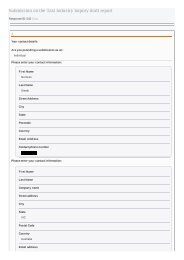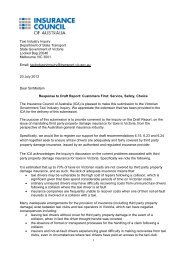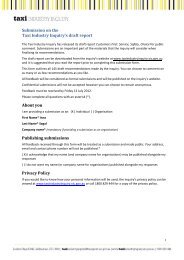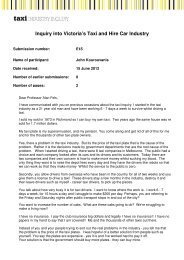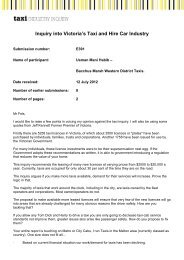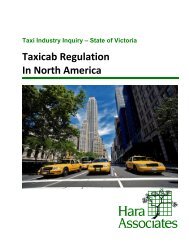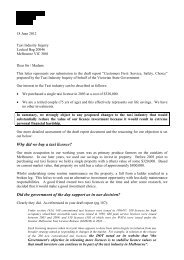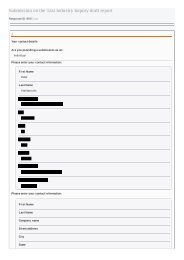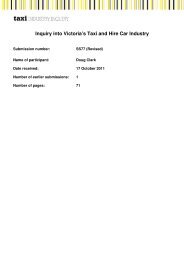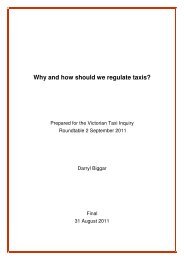Part D â Understanding and improving industry performance (PDF ...
Part D â Understanding and improving industry performance (PDF ...
Part D â Understanding and improving industry performance (PDF ...
You also want an ePaper? Increase the reach of your titles
YUMPU automatically turns print PDFs into web optimized ePapers that Google loves.
Chapter 12.<br />
12. Payment systems<br />
Key messages<br />
• Unlike most other goods <strong>and</strong> services, all<br />
electronic payments in Victorian taxis attract<br />
a ‘service fee’ or surcharge of at least 10<br />
per cent of the total fare (in addition to GST).<br />
This surcharge costs taxi users at least $30<br />
million per year <strong>and</strong> appears to be well in<br />
excess of the costs incurred in processing<br />
such payments.<br />
• High surcharges on taxi fares are linked to<br />
both a lack of competition in the payments<br />
systems markets <strong>and</strong> to markets in which taxi<br />
services are supplied. This lack of competition<br />
stems from significant barriers to entry <strong>and</strong><br />
expansion for firms seeking to process noncash<br />
payments <strong>and</strong> the limited incentives for<br />
taxi operators <strong>and</strong> networks to compete by<br />
offering lower surcharges to taxi users.<br />
• The Victorian Government has inadvertently<br />
created barriers to entry to the payment<br />
instruments <strong>and</strong> payment processing market<br />
through (a) its policies allowing Cabcharge to<br />
be the sole provider of data collection services<br />
for the Multi Purpose Taxi Program (MPTP)<br />
<strong>and</strong> (b) through the approvals process for<br />
EFTPOS terminals in cabs. These barriers<br />
can <strong>and</strong> should be removed.<br />
• Existing competition in payments processing<br />
focuses on attracting taxi operators <strong>and</strong><br />
drivers by offering rebates funded from the<br />
prevailing 10 per cent surcharge. On average,<br />
these rebates account for around half of<br />
the surcharge.<br />
• Even if some barriers to competition in<br />
payments processing are lowered – such<br />
as access to processing Cabchargebr<strong>and</strong>ed<br />
cards <strong>and</strong> the removal of the<br />
MPTP Cabcharge monopoly – the 10 per<br />
cent surcharge is likely to remain common<br />
practice. Market pressure for a reduction in<br />
the surcharge will only occur if <strong>and</strong> when taxi<br />
operators <strong>and</strong>/or network service providers<br />
compete effectively for consumers.<br />
• There are some technological developments<br />
that offer the promise of lower fees to taxi<br />
users. It will be important to ensure that<br />
regulation facilitates, rather than stifles,<br />
such innovation.<br />
• The Australian Competition <strong>and</strong> Consumer<br />
Commission <strong>and</strong> Reserve Bank of Australia<br />
are well placed to oversee <strong>and</strong> enforce<br />
regulation of anti-competitive behaviour in the<br />
payments systems market.<br />
A number of concerns have been<br />
raised with the inquiry in relation<br />
to in-cab payment systems, most<br />
notably the 10 per cent ‘service fee’<br />
or surcharge that applies to electronic<br />
payments <strong>and</strong> the lack of competition<br />
in the payments instruments <strong>and</strong><br />
payment processing markets.<br />
This chapter outlines concerns about taxi payment<br />
systems raised in submissions <strong>and</strong> consultations.<br />
It describes the history of these systems <strong>and</strong> the<br />
characteristics of the payment systems market. It<br />
discusses market concentration <strong>and</strong> vertical integration<br />
(including Cabcharge’s dominance of the market),<br />
regulatory <strong>and</strong> commercial barriers to entry, the behaviour<br />
of payment processing providers <strong>and</strong> the potential effects<br />
of technology. Finally, the chapter discusses options for<br />
reform to enhance competition <strong>and</strong> reduce the 10 per<br />
cent surcharge currently imposed on Victorian taxi users.<br />
12.1. Introduction<br />
As with most other goods <strong>and</strong> services, taxi fares can be<br />
paid by a variety of methods. Passengers can use cash,<br />
debit cards, credit cards (such as Visa <strong>and</strong> MasterCard)<br />
or third party charge cards (such as American Express<br />
<strong>and</strong> Diners Club). They can also obtain an electronic or<br />
paper-based taxi-specific payment instrument (a card or<br />
voucher) prior to commencing the trip <strong>and</strong> have the fare<br />
charged to a personal or business account.<br />
250




